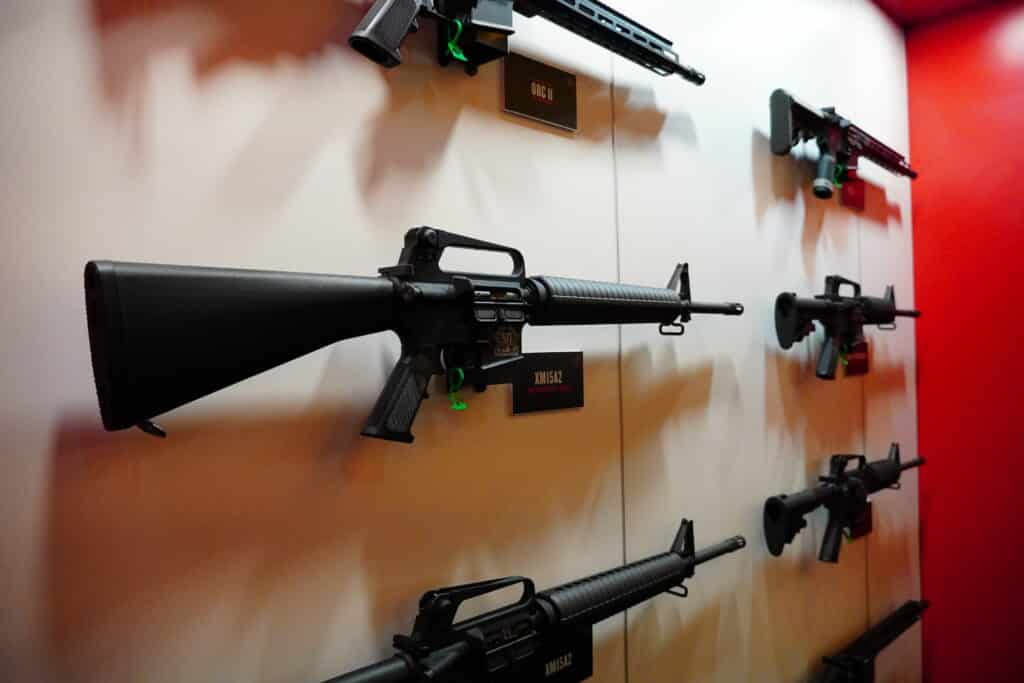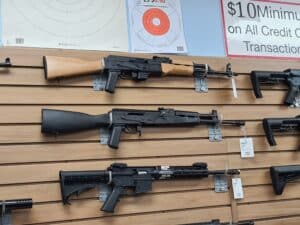The Reload has officially made it to our three-year anniversary! Our sober, serious approach to firearms journalism has led to dozens of exclusive stories that have changed the political and legal landscape around guns in America. We quite literally couldn’t have done it without the support you, our members, have provided.
We want to especially thank those of you who’ve been with us from the beginning. In fact, we’re going to extend our launch discount through the end of the year to drive that thanks home.
Now, on to the news.
This week, we got a new industry estimate for how many “large capacity” magazines are out there. It’s a lot. But will it make a difference in the legal fight over bans on them? Contributing Writer Jake Fogleman tries to answer that question.
Gun-rights lawyer Kostas Moros returns to explain why he believes those defending the Illinois AR-15 ban have made a strategic mistake in their recent brief with the Supreme Court. He says some of the arguments they’re relying on make the Court more, not less, likely to take up the case and reverse the lower court’s decision to uphold the ban.
I take a closer look at the downturn in mass shootings as well. Mercifully, we’ve yet to see one this year. Unfortunately, that doesn’t necessarily mean we’ll end the year with fewer mass shootings than in recent years.
Plus, data analyst Jeff Asher joins the podcast to examine the murder rate decline.

Analysis: Will Ammo Magazine Report Move the Needle in Court? [Member Exclusive]
By Jake Fogleman
A new industry study provides clear evidence that magazines capable of holding more than ten rounds are ubiquitous in the United States. Whether that finding affects magazine ban lawsuits moving forward is less clear.
The National Shooting Sports Foundation (NSSF) released its Detachable Magazine Report last week. Using more than 30 years of ATF research and manufacturer survey data, it estimated 963.7 million rifle and pistol magazines entered the commercial firearms market between 1990 and 2021. Of those, 717.9 million, or 74 percent, were found to have a capacity of 11 or more rounds.
“The data establishes that law-abiding gun owners overwhelming choose magazines that have a capacity to hold more than ten rounds for lawful purposes including self-defense, target shooting and hunting,” Larry Keane, NSSF’s General Counsel, said of the report.
The report’s findings, and Keane’s comments, take direct aim at the legal fight over bans on those magazines.
NSSF’s decision to group magazines into categories with ten rounds as the dividing line is intentional, with an eye toward the county’s most common “large capacity” magazine bans. Of the 14 states that currently ban magazines, 12 set the legal limit at ten rounds. Meanwhile, Keane’s emphasis on the “overwhelming” nature of gun owners’ use of those magazines “for lawful purposes” mirrors the Supreme Court’s own words detailing which arms the Second Amendment protects.
In its 2008 D.C. v. Heller decision, the Court’s majority determined that the Second Amendment’s plain text protects arms “typically possessed by law-abiding citizens for lawful purposes,” based on its reading of the 1939 case United States v. Miller.
“We think that Miller’s ‘ordinary military equipment’ language must be read in tandem with what comes after: ‘[O]rdinarily when called for [militia] service [able-bodied] men were expected to appear bearing arms supplied by themselves and of the kind in common use at the time,'” Justice Antonin Scalia wrote. “The traditional militia was formed from a pool of men bringing arms ‘in common use at the time’ for lawful purposes like self-defense.”
“We therefore read Miller to say only that the Second Amendment does not protect those weapons not typically possessed by law-abiding citizens for lawful purposes, such as short-barreled shotguns,” he added. “That accords with the historical understanding of the scope of the right.”
With Heller being the last significant arms ban case the Court has decided, that guidance still informs how lower courts evaluate which modern weapons, including magazines, are protected by the Second Amendment.
Armed with new research suggesting America has more than twice as many “large capacity” magazines than people, gun-rights advocates will be hoping they can definitively prove that they are “in common use.”
However, that isn’t really what the sticking point has been in magazine ban lawsuits that have gone against them with near unanimity to date.
Rather than disputing whether Americans commonly own magazines capable of holding more than ten rounds, many of the judges who have upheld the bans instead focused on what it means for an arm to be “in common use” and which uses count as “lawful purposes.”
That question was central to Oregon, Washington, and Rhode Island rulings.
“This Court acknowledges that there may be lawful purposes other than self-defense for which an individual can use a firearm,” Judge Karin Immergut wrote in Oregon Firearms Federation v. Kotek. “While these uses may be lawful, they have never been explicitly recognized as being ‘the central component’ of the Second Amendment right; only self-defense enjoys that kind of unique focus within the Supreme Court’s caselaw. Accordingly, this Court finds that the Second Amendment protects an individual right to commonly used firearms for the central purpose of self-defense.”
Immergut ruled that gun-rights litigants would have to prove that self-defense encounters regularly call for more than ten shots for her to find they are “in common use” for that purpose.
“This Court finds that an individual’s subjective intent in purchasing a firearm or firearm accessory for self-defense, while relevant, also cannot be dispositive in assessing whether a firearm or firearm accessory is in common use for self-defense,” she wrote.
Because empirical research currently suggests that most civilian defensive gun uses require few, if any, shots, she ultimately ruled that “the Second Amendment does not protect [Large Capacity Magazines].”
This reading of what makes an arm “in common use” has not been the only factor in hardware ban rulings thus far. Other courts that have upheld magazine bans instead found the affected magazines have caused “unprecedented societal concerns” that allow for a looser approach to historical gun laws.
Additionally, at least one federal judge has directly rebuked this interpretation of the common use standard while striking down California’s magazine ban. The Supreme Court may do the same if it decides to take another hardware ban case in the future.
After all, Justice Scalia’s rationale for finding handguns to be “in common use” for lawful home defense in Heller did not rely on case studies of scores of defensive gun uses. He was instead satisfied with the subjective reasonings of individual gun owners who purchased them for that purpose.
“There are many reasons that a citizen may prefer a handgun for home defense: It is easier to store in a location that is readily accessible in an emergency; it cannot easily be redirected or wrestled away by an attacker; it is easier to use for those without the upper body strength to lift and aim a long gun; it can be pointed at a burglar with one hand while the other hand dials the police,” he wrote. “Whatever the reason, handguns are the most popular weapon chosen by Americans for self-defense in the home, and a complete prohibition of their use is invalid.”
But until the High Court decides for itself whether the same is true for commonly owned magazines, empirical studies on magazine ownership likely won’t be the silver bullet for gun-rights advocates in the lower courts.

Analysis: Illinois Tempts Fate in SCOTUS Defense of AR-15 Ban
By Konstadinos Moros
Illinois may have just increased the odds the Supreme Court takes up an “assault weapons” ban case sooner than later.
Predicting when the Supreme Court will grant certiorari is generally a fool’s errand, as most petitions for review are ultimately denied. When it comes to appeals from preliminary injunction rulings especially, the high court tends to be loath to get involved because it prefers to wait for final judgments and circuit splits. Those are the tough circumstances facing the several Second Amendment-related cert petitions currently pending before the Court, and no one should be surprised if all are ultimately denied until they come back up with final judgments.
However, some recent arguments raised in the legal fight over an Illinois AR-15 ban may tempt the Court to intervene. This week, the State of Illinois filed its brief in opposition to the several pending cert petitions seeking to reverse the Seventh Circuit’s ruling in Bevis v. City of Naperville. In it, Illinois made several arguments the majority of the Court might feel the need to rebut.
The first is the embrace of the purported new Bruen “two-step test” many courts have adopted. Under this reading of Bruen, the burden is first on plaintiffs challenging a law to show the Second Amendment is implicated before the all-important historical analysis even occurs. This approach is erroneous because Bruen clearly calls for a one-step test. Surely, the Court did not intend to replace the two step, tiers-of-scrutiny analysis it explicitly rejected with yet another two-step test. As the Court said, “[d]espite the popularity of th[e] two-step approach, it is one step too many.”
To be sure, for there to be a viable Second Amendment challenge, the right to keep and bear arms must at least be implicated. Just as a First Amendment free speech case must involve speech, so too must a Second Amendment case involve the peaceable use or ownership of arms. But this should be no more than a simple qualifier, not an independent “step” requiring in-depth analysis.
The second argument that may invite early Supreme Court scrutiny is closely related to the first: Illinois’ contention that the Seventh Circuit was correct in concluding that so-called “assault weapons” are not even “arms” protected by the Second Amendment. Following that circuit court’s logic, Illinois argues that the Second Amendment was never intended to protect weapons that are “exclusively or predominantly used by the military.” Because rifles like the AR-15 are similar to M-16s, Illinois argues, they are too much like military firearms to earn any Second Amendment protection.
This argument may be troubling to the Supreme Court because it ignores that Heller defined what “arms” are in the Second Amendment context using 18th-century dictionaries, including one that explained that “arms” are “any thing that a man wears for his defence, or takes into his hands, or useth in wrath to cast at or strike another.” Bruen reaffirmed that this includes all “modern instruments that facilitate armed self-defense, even those that were not in existence at the time of the founding.” Heller also rejected any attempts by the government to second guess what Americans choose to use for self-defense when it explained that “[w]hatever the reason, handguns are the most popular weapon chosen by Americans for self-defense in the home, and a complete prohibition of their use is invalid.”
But even if the banned firearms are “arms” under the plain text of the Second Amendment, Illinois argues they may still be restricted because there is a tradition of “reserving some [firearms], if appropriate, to the military or law enforcement.” If the Supreme Court is truly as focused on a historical test as it said it was in Bruen, then this argument alone warrants immediate intervention to correct the Seventh Circuit.
In truth, there is not and has never been a rule that arms may be banned just because they may also be used by the military. The supposed “distinction between military and civilian weaponry” the Seventh Circuit insisted on is a fabrication. As Judge Michael B. Brennan pointed out in his dissent, the military uses many firearms that are also commonly used by civilians, making the majority’s ruling nonsensical in practice.
“Under the majority opinion, the military’s decision to award Beretta a military contract for the Beretta 92 would take the firearm out of the ‘Arms’ protected by the Second Amendment,” he wrote.
If there is one thing that the founders and the first few generations of Americans after them were abundantly clear on, it is that the Second Amendment exists in large part as a guard against tyranny, regardless of whether such tyranny comes from a foreign invader or the government itself. Tench Coxe, a delegate to the Constitutional Convention, wrote that “[w]hereas civil rulers, not having their duty to the people duly before them, may attempt to tyrannize, … the people are confirmed by the article in their right to keep and bear their private arms.” And the Second Amendment’s original meaning was not understood any differently in the 19th century.
Indeed, many commentators singled out the “arms of modern warfare” as what the Second Amendment protected most of all. Writing in 1868, John Norton Pomeroy explained that “a militia would be useless unless the citizens were enabled to exercise themselves in the use of warlike weapons.” Similarly, Henry Campbell Black wrote in 1895 that “[t]he citizen has at all times the right to keep arms of modern warfare.”
Dozens of other examples abound, and many of them are covered in my recent law review article on this very topic. There isn’t a historical tradition of barring common arms just because they may be useful in combat when one of the main purposes of the Second Amendment was to be, as one judge put it, a “doomsday provision” for the people to protect themselves from tyranny.
None of this is to say that weapons used by the military which are shown to be “dangerous and unusual” can never be restricted. As District Judge Roger Benitez explained in his Duncan ruling addressing California’s magazine capacity law, history and tradition might support restricting weapons “useful solely for military purposes.” But the firearms banned by Illinois are not surface-to-air missile systems or warheads; they are some of the most popular and common firearms in the country.
Finally, at least some Justices may take issue with Illinois’ and the Seventh Circuit’s argument that the popularity of the banned firearms is not enough to grant them any protection. This appears to be in direct contradiction to what Justice Alito said in his concurring opinion in Caetano, where he noted that stun guns were protected in part because hundreds of thousands (but not millions) of Americans owned them. Here, the situation is far more clear cut, because tens of millions of Americans own firearms that Illinois has banned. Several estimates put the number of AR-15s alone at over 20 million. Illinois has questioned numbers coming from Georgetown University Professor William English and the National Shooting Sports Foundation. But a Washington Post survey has also found about 1 in 20 Americans own an AR-15, or roughly 16.5 million people. Whatever the “floor” is for commonality, estimates from a range of sources make it clear that the AR-15 certainly meets it.
So, the Court may be moved to accept the case at this early stage after reading Illinois’ brief. Or it could opt to grant, vacate, and remand the Seventh Circuit’s opinion with instructions on how to properly go about the Bruen analysis. This would temporarily save the Court from having to decide such a high-profile issue for the time being, while still helping to correct the errant circuit. Of course, the Supreme Court may also be content to take a more traditional path by waiting to grant review on an “assault weapons” ban case until after one has reached final judgment.
Whatever it actually decides to do, Illinois’s making these arguments probably increases the odds that the Court will act soon.
NOTE: Kostas Moros is an attorney who is working on Federal Firearms Licensees of Illinois v. Pritzker, which is also challenging the Illinois ban. However, the arguments in this article are his alone and are not made on behalf of any clients, other petitioners, or the law firm where he works.
Podcast: Crime Data Analyst Jeff Asher Explains 2024’s Murder and Mass Shooting Decline [Member Early Access]
By Stephen Gutowski
The murder rate is falling again, and mass shootings have been absent so far this year.
This is good news, but it’s also a bit confusing. Why is the murder rate dropping after several years of increasing? Is the same effect happening with mass shootings? Does the data show the two are connected?
That’s why we’ve got data analyst Jeff Asher back on the show. He runs AH Datalytics and collects his own crime statistics. He joined us last year when his crime data suggested 2023 would see a huge downturn in murder across the country. He was right.
This year, he’s seeing an even larger decline. Mass shootings are down, too. Whatever definition you use for the awful phenomenon, and we discuss the pros and cons of the different ones out there, the downtrend is interesting–especially since it now appears to track with overall murder.
Jeff does his best to explain why these trends are happening and look forward, though he emphasizes the future is impossible to predict.
You can listen to the show on your favorite podcasting app or by clicking here. Video of the episode is available on our YouTube channel. An auto-generated transcript of the episode is here. Reload Members get access on Sunday, as always. The show goes public on Monday.
Plus, on this week’s news update, Contributing Writer Jake Fogleman and I discuss Maine’s new waiting period and background check laws, a new Iowa Bill allowing armed teachers, and an update on Colorado’s push to ban “assault weapons.” We also cover a new industry study showing the popularity of so-called large-capacity magazines, and why the government of Washington D.C. just settled its lawsuit against the NRA. Audio is available here. Video is available here.

Analysis: Will 2024 See Fewer Mass Shootings? [Member Exclusive]
By Stephen Gutowski
There hasn’t been a mass shooting so far this year, but that doesn’t necessarily mean we’ll see fewer than in recent years.
As of April 18th, The Violence Project (VP) hasn’t identified any mass shootings in 2024. That means there haven’t been any public shootings unrelated to gang or criminal activity where four or more people were killed.
It comes as preliminary data shows the murder rate has continued to fall through the beginning of the year as well. The same is true for all of the broader definitions of mass shooting employed by the Gun Violence Archive (GVA).
Everything shows a downward trend.
That’s not so surprising when it comes to the broader counts. This is especially true for the Gun Violence Archive, whose count includes any incident where four or more are injured and has fallen about 30 percent compared to the same time in 2023. Its count is probably dropping for the same reason critics say it’s a poor gauge of mass shootings: the low bar it uses tends to capture lots of events that most people wouldn’t recognize as mass shootings and are more like everyday violence.
Since the GVA count captures a lot of gang or street crime and a larger chunk of overall murders, it makes sense it would track closer to the general murder rate. However, the GVA count has actually risen at a much faster rate than the overall murder rate. It also didn’t decrease alongside 2023’s murder rate drop but now seems to be catching up as the number of GVA incidents is falling faster than the murder rate.
Part of that could have to do with the fact that GVA uses media reports to track shootings where four or more are injured, which may lead to incidents being missed or misreported. In fact, the publicity GVA has brought to these kinds of attacks may even have made coverage of them, or at least outlets emphasizing the victim counts involved, more common in and of itself.
Either way, a count that captures many more shootings should more closely reflect the overall level of American violence than more restrictive counts. A significant drop in all shootings and murders ought to result in fewer GVA incidents at scale.
The same isn’t necessarily true for the kind of mass shootings the VP count tracks. Since the VP definition filters out more common attacks with criminal motivations, it captures events that are much more distinct from other forms of gun violence. That makes its count a lot more in line with what most Americans likely imagine when they think of mass shootings, and those events are uniquely resistant to overall violence trends.
That’s why the absence of mass shootings through April could just be a mirage. Mass shootings happen in a fairly unpredictable pattern. It’s not that unusual to go months between mass shootings only to have two or three occur in quick succession.
That clustering has been the topic of debate for years. Some argue it’s evidence of a short-term contagion effect, while others say it’s just the result of randomness in a small sample size. In fact, the random and sporadic nature of the shootings makes any short-term trends in mass shootings hard to scrutinize.
“I’ve always found the more restrictive definition of a mass shooting to be too…restrictive…making it hard to know what any changes mean,” Jeff Asher, a crime analyst at AH Datalytics, told The Reload. “I’d say that the base rate of these types of incidents is so low that randomness could be responsible for any change from year to year.”
To this point, 2022 didn’t see a mass shooting until May 14th. Then, it experienced three within a month, including the horrendous Uvalde shooting. That year saw seven mass shootings before it was over, according to the VP count.
One of the most remarkable things about mass shootings is how stable their frequency has been over the years. Since 2017, VP’s database shows every year has seen between seven and nine mass shootings. The lone exception was 2020, when lockdowns and social distancing policies made large public crowds rare.
That’s surprising, considering a shooting only gets counted when an attacker manages to kill at least four people. There are a lot of variables that contribute to whether somebody trying to carry out a mass shooting can actually do so. The FBI’s most recent active shooter report bears that out. Fewer attempts were made to shoot groups of people in public spaces in 2022 than 2021, but more resulted in mass killings and more people were killed overall.
Further, the FBI’s count of active shooter incidents in recent years shows very little correlation to the number of mass shootings in the VP database.
The same is true for the murder rate. There’s very little connection there, either. So, it is hard to predict whether the falling murder rate or the recent lack of mass shootings means we’ll see fewer horrific acts of spectacular violence by the end of the year.
But we can certainly hope that’s the case. And, if it does turn out that way, perhaps it will give us some new insight into how to prevent mass shootings moving forward.
That’s it for now.
I’ll talk to you all again soon.
Thanks,
Stephen Gutowski
Founder
The Reload








Only Members can view comments. Become a member today to join the conversation.